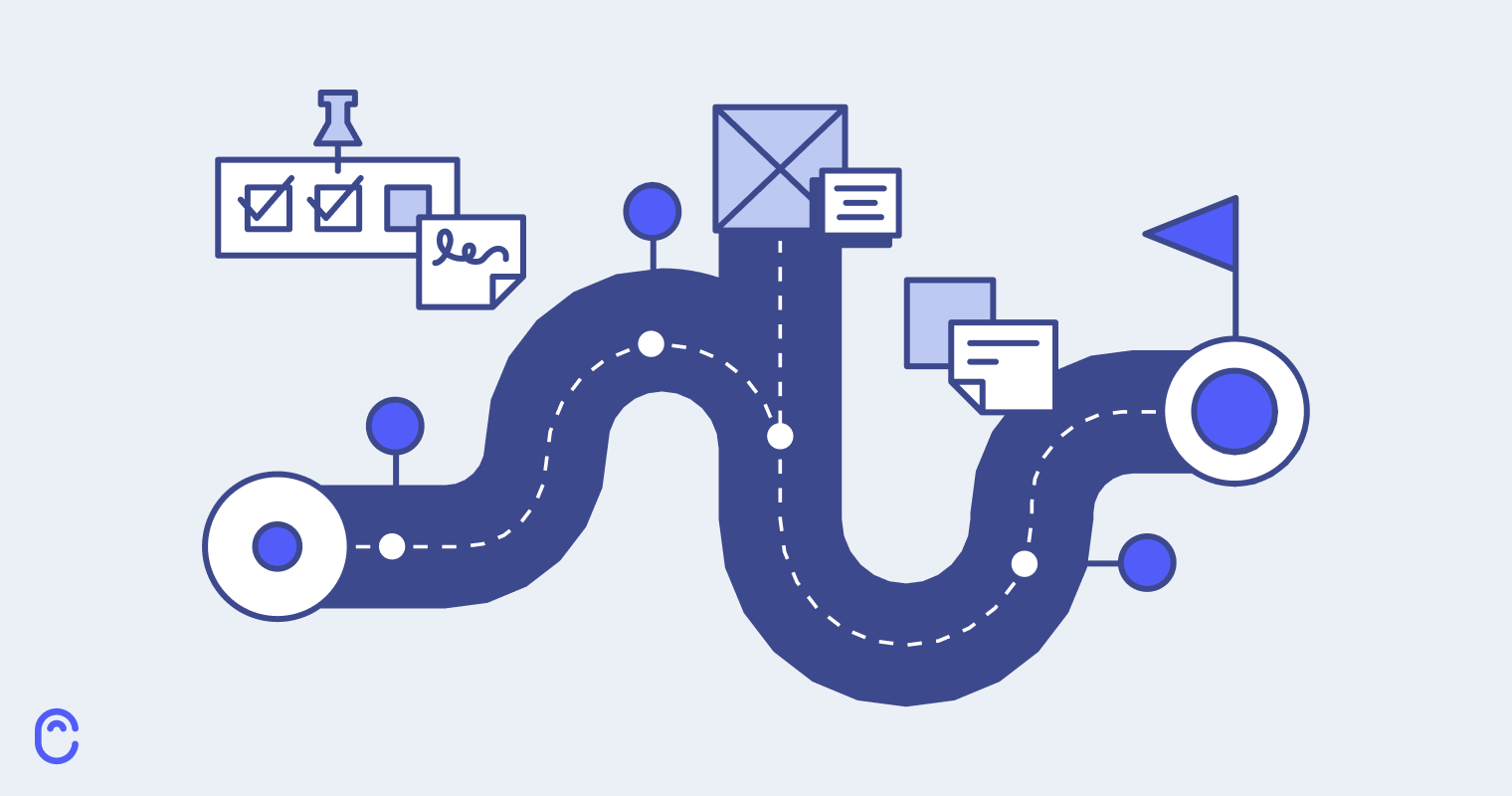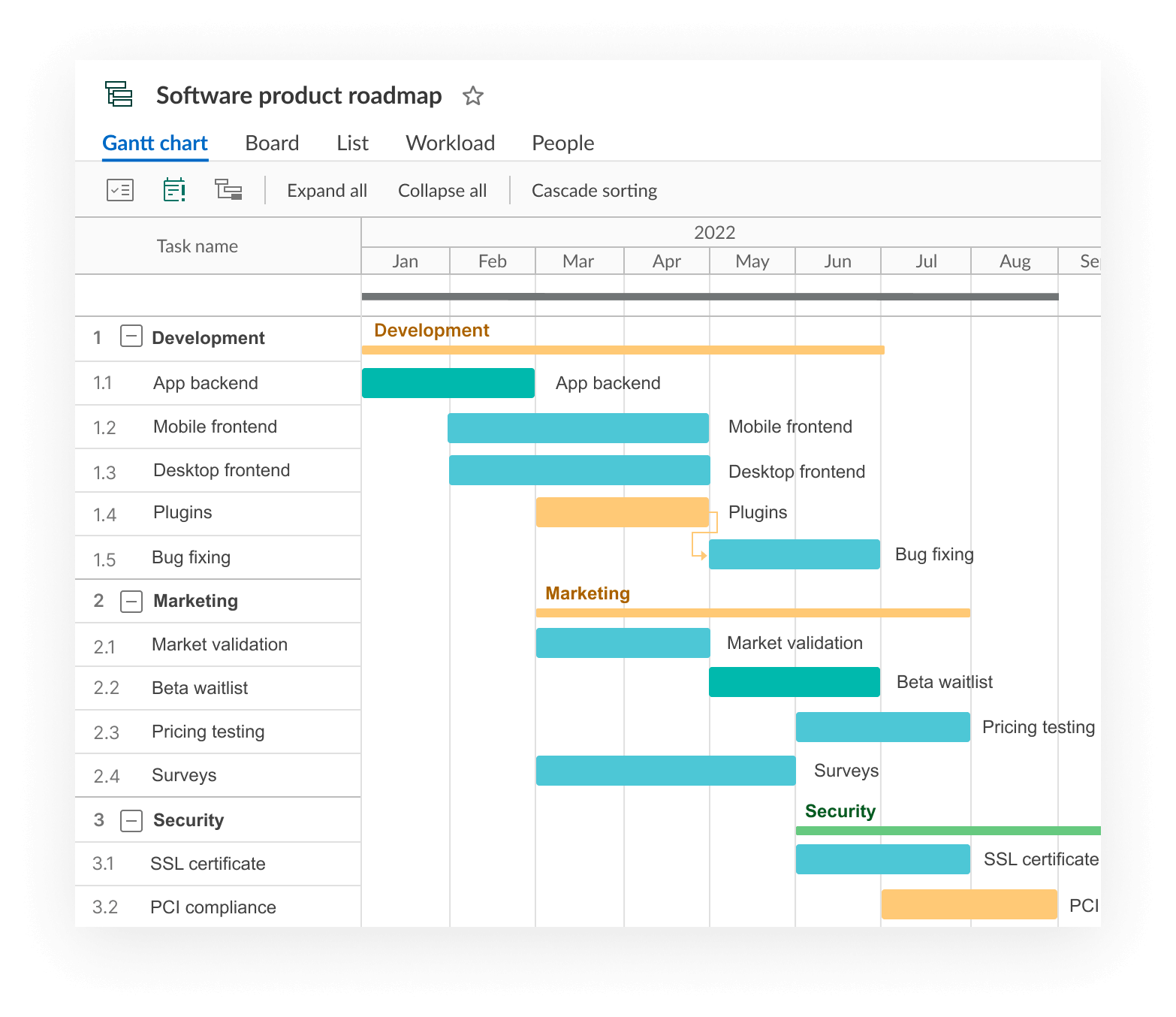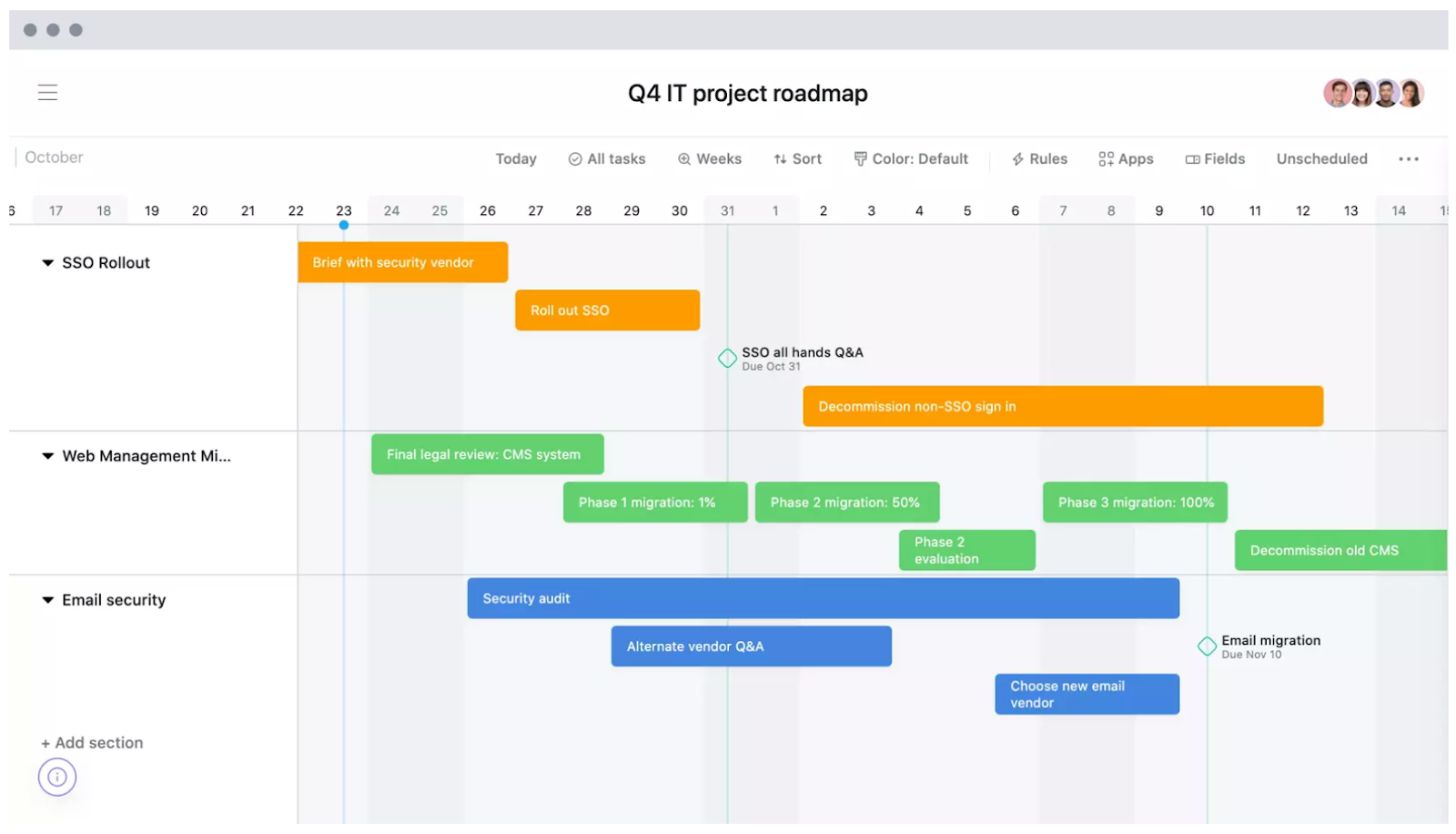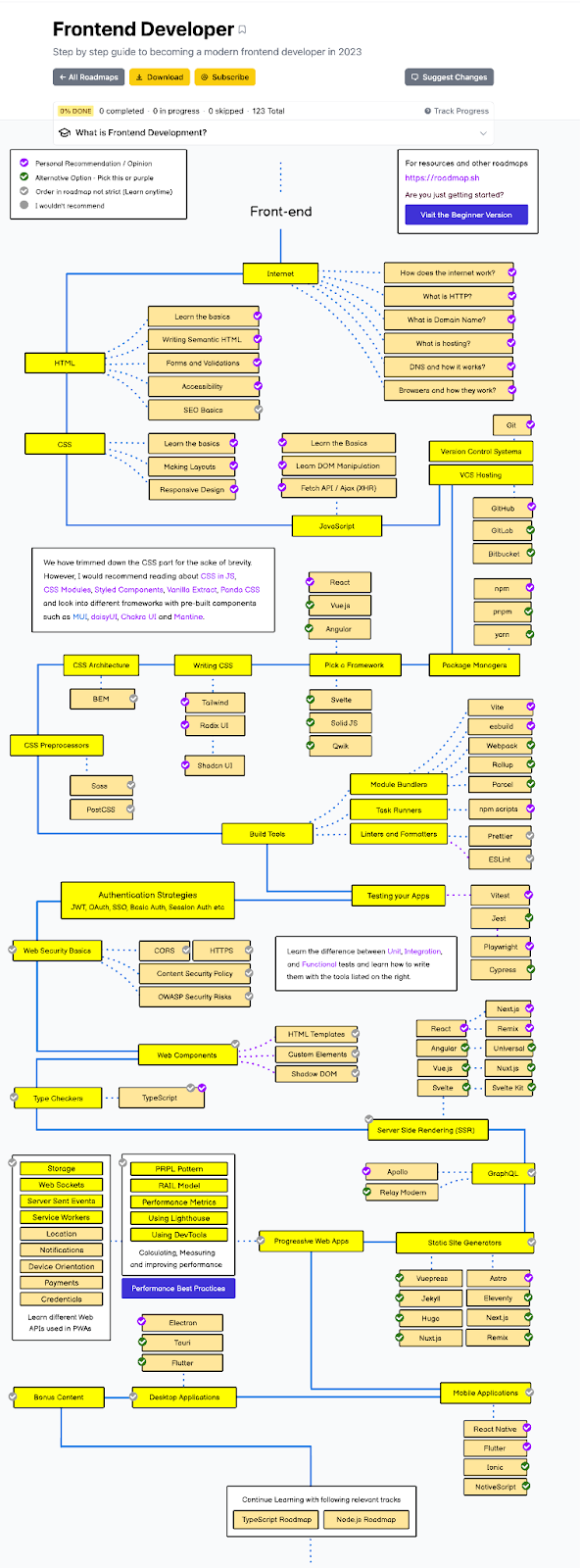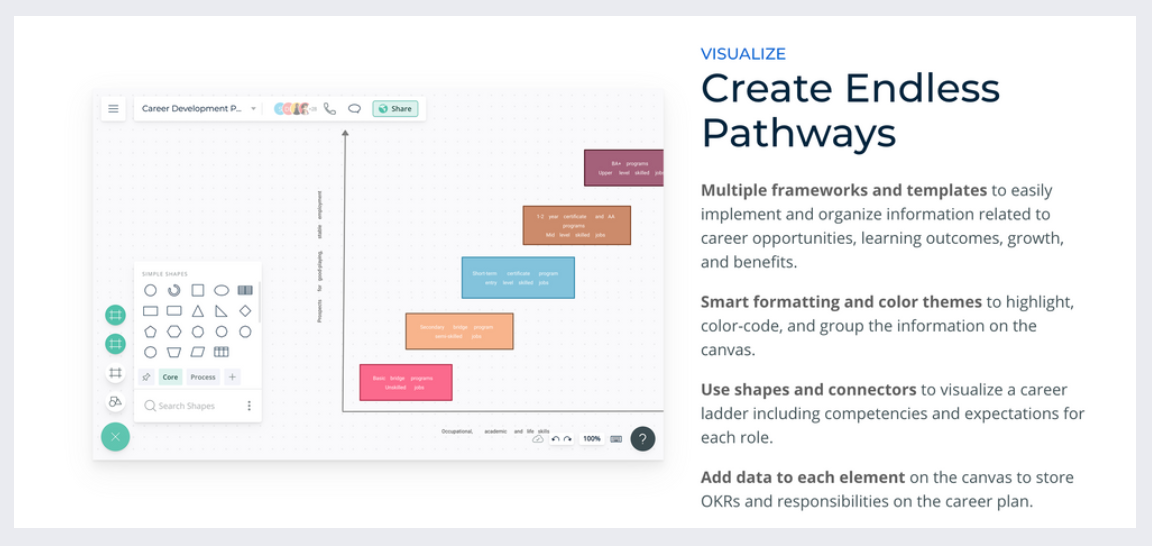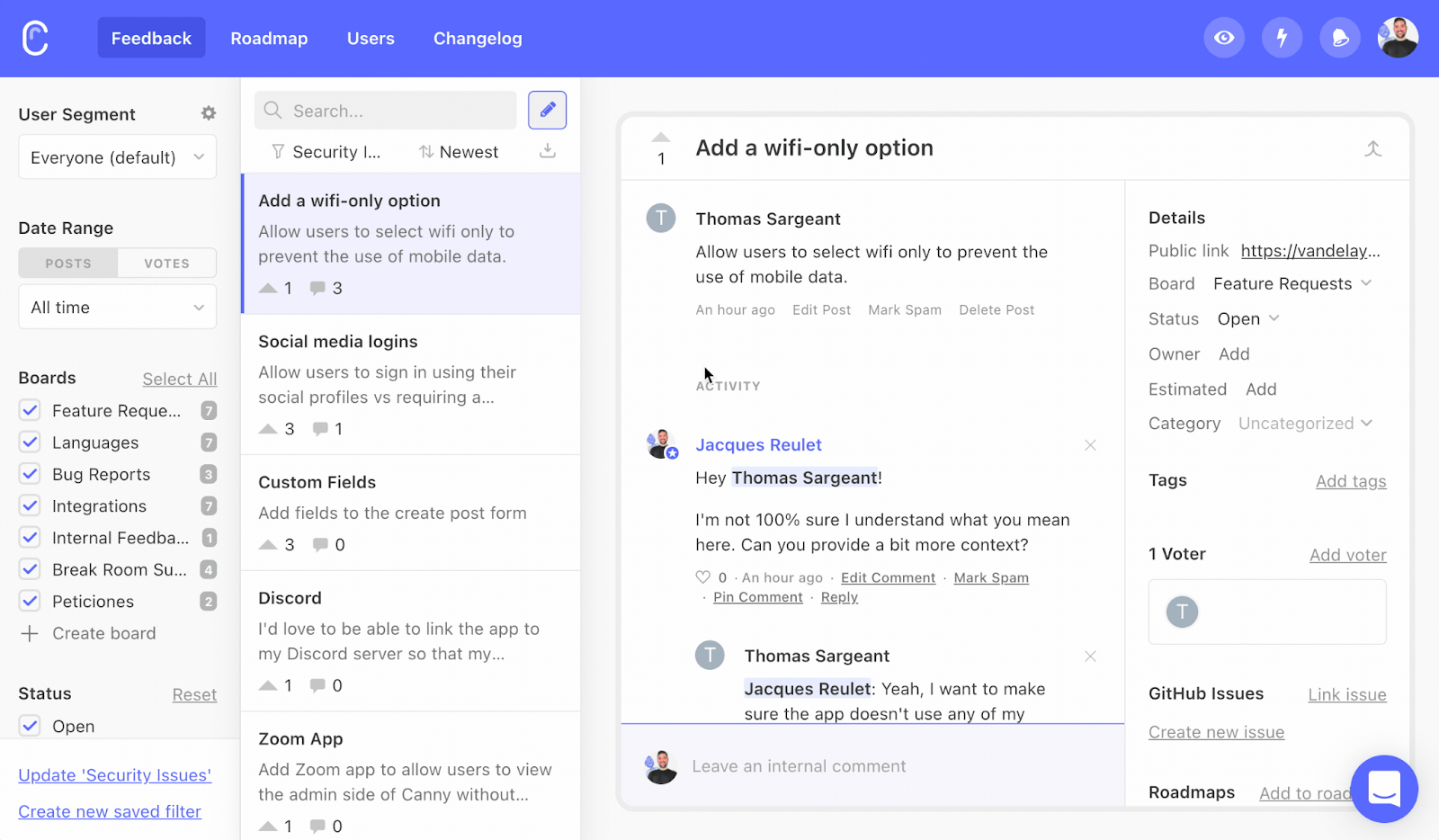Remember the time you tried to assemble that IKEA shelf without the manual? Neither do we. That’s because we know the value of a good guide. And in the world of product management, that guide is our beloved product roadmap.
A product roadmap is like your North Star in the vast universe of product development. It’s a visual representation of your product’s direction, priorities, and progress over time.
We’re going to focus on product roadmaps in this article. But, we’ll discuss and show examples of other roadmap types, too.
We’ll also explain how to build and use a roadmap. These principles apply to many types of roadmaps, not just the product ones. We’ll also explore product roadmap software that makes managing roadmaps a breeze.
Let’s dive deep into the world of roadmaps and break it all down.
What is a roadmap?
A roadmap is like a plan that shows how to build a product step by step. It helps everyone involved understand what we are making and when things will happen. This plan lists all the important tasks and when they need to be finished. It helps keep everyone on the same page and focused on what is most important right now.
A roadmap is very useful because it makes sure that the team works together well. It points out the main steps we need to take, which helps us use our time and resources wisely. It also shows which tasks are the most important, so we can do those first. Prioritization helps determine that.
There are lots of different types of roadmaps:
We’ll cover them later in this article.
Why do you need a roadmap?
Here are a few reasons to start building a product roadmap.
- Strategic alignment
It ensures everyone’s paddling in the same direction.
- Sales teams won’t promise some features that PMs aren’t even aware of
- Marketing won’t build campaigns for features that aren’t in the works
- Design won’t create wireframes for low-priority features
You get the idea.
- Stakeholder communication
A roadmap is like a translator between you and your key stakeholders. There will always be people who want certain features shipped yesterday. How can you effectively communicate your current priorities? With a product roadmap, of course!
- Resource planning
Knowing what you’re building will help determine which resources you need. You’ll also know when you need them, in what quantities, and how crucial they are. Planning simplifies everything! If you plan properly, you won’t end up with too many or too few resources.
Now that we know why roadmaps are so crucial, let’s talk about who’s involved.
Who should create the roadmap?
Navigating the vast seas of product development requires a clear map and a skilled crew. For example:
Product managers (PMs)
That’s us! The captains of the ship. As a product manager or a product owner, you’re at the heart of the product’s journey. You understand the product vision, the users, and the market. Your role is to ensure that the product’s direction aligns with the business goals and user needs. You’re setting the course, deciding which ports (features) to visit, and ensuring the crew (development team) knows the route.
Project managers
The vigilant navigators. While a PM sets the course, a project manager ensures smooth sailing. They have a keen eye on the timeline, resources, and potential obstacles. Project management helps us avoid hitting icebergs or getting caught in storms. We call them “unexpected challenges”.
Project managers work closely with the product team to ensure the roadmap is feasible. They also help coordinate the division of work and see projects to completion.
Founders
You might not have a large team yet. In this case, you likely have someone else in charge of the roadmap. If you’re operating a startup, founders likely own the roadmap. If you’re a startup founder trying to navigate the world of roadmaps, you’re in the right place!
Engineers
Similar to the point above, sometimes other team members manage the roadmap before a dedicated product owner comes on board. Engineers and product developers have deep insights into the inner workings of the product. So they’re well suited to manage the product roadmap.
C-level executives
They are the admirals looking at the bigger picture. They might not be involved in the day-to-day plotting of the course, but their vision is still crucial. They have a bird’s-eye view of the entire fleet (company). They also ensure that our ship (product) aligns with the broader fleet’s direction. They get insights from market trends, company and product strategy, and financial factors. These insights can significantly impact the roadmap’s primary goals.
While the product manager might be the primary cartographer of the roadmap, it’s a collaborative effort. Each role brings a unique perspective, ensuring that the roadmap is not only visionary, but also grounded in reality. After all, a map is only as good as the team that uses it!
Speaking of roadmap users – let’s discuss them next.
Who uses the roadmap?
Don’t let your product roadmap become another file lost in your Google Drive! It’s a living, breathing guide that serves multiple audiences. So encourage people to use it! Let’s explore who can benefit from this invaluable tool.
- Internal team
Why? So the devs don’t go rogue on you.
Internal teams are the engine room of our product ship. This includes developers, designers, and QA testers. They turn the roadmap’s vision into reality. And they all need a holistic view of where the product is headed. It helps them understand the context of their tasks.
They also learn the priority of new features. Plus, they discover the interdependencies between different components. This clarity reduces the chances of misalignment or “wildcard” features that haven’t been accounted for. It’s like giving them a compass to make sure they’re always sailing in the right direction.
- External stakeholders
Why? To keep them in the loop.
External stakeholders include investors, partners, and board members. They might not be involved in the daily grind but are still vested in the product’s success.
The roadmap is a snapshot of the product’s strategy, progress, and future direction. By sharing it with them, we’re fostering trust, setting expectations, and ensuring they’re always informed. It’s like sending them a postcard from our journey, letting them know we’re on the right track.
These stakeholders care where their money is going. If they have a way to always check in on your progress, they’ll have much more trust in you. Raising more funds will get easier!
Customers
Why? Transparency is the best policy.
In some industries, especially in the SaaS world, companies choose to share their roadmaps with their customers. When done right, this strategy can foster trust and set realistic expectations. This also creates an open communication stream. Customers can send you valuable feedback for future improvements.
They also appreciate being in the know. A public roadmap can make them feel valued and heard. It’s like inviting them on the journey with us, ensuring they know where we’re headed and why.
Curious to see how PMs build in public? Here are some of the best public roadmap examples.
Let’s talk about other types of roadmaps now.
Other types of roadmaps
Up until now, we’ve been focused on product roadmaps. There are also other types of roadmaps that you might find useful.
While product roadmaps are our bread and butter, the concept of roadmapping extends to various domains. Each type serves a unique purpose, catering to different audiences and objectives. Let’s delve deeper into these diverse roadmaps.
Technology roadmap
Purpose: navigate your tech projects
A technology roadmap shows the company’s plan to use new technology. This document helps the company connect its technology needs to its business goals. Your tech roadmap should align with your product roadmap. It lays the foundation your product is built on.
For the tech team, it’s like having a crystal ball that predicts the future of technology within the organization. Here’s what it might look like:
Software development roadmap
Purpose: “When’s the next update?”
This roadmap is tailored for software products. It details the upcoming features, improvements, and releases. It’s a timeline of developers’ work and when users can expect updates. It’s like a product release calendar, ensuring everyone knows when the next software “season” premieres.
Some companies use their product roadmaps as a software development roadmap. If your roadmap is focused just on engineering, it’s likely a software development roadmap. If it includes other team members (designers, product marketers, etc), it’s a product roadmap. However, the lines may blur.
Here’s what a software roadmap might look like.
Business roadmaps
Purpose: zoom out to the bigger picture
This roadmap shows the company’s strategic plans, goals, and priorities at a high level. It brings different departments together to work towards the same goals. Think of it as the company’s strategic blueprint.
Here’s an example of a business roadmap:

“Business” is a broad term. You can also separate a few other roadmaps.
Marketing roadmap
Purpose: to spread the word about your products
This roadmap shows the plans for marketing and promoting products or services. It’s the game plan for brand visibility, ensuring the right message reaches the right audience at the right time.
A product can be exceptional, but you need users to make it profitable. That’s why outlining your marketing initiatives is so crucial.
When your product is complex, it’s easy to get confused while trying to promote it.
A marketing roadmap can help. Here’s an example of a marketing roadmap.
Let’s explore more roadmaps to help you stay organized.
Innovation roadmap
Purpose: “What’s the next big thing?”
An innovation roadmap is all about staying ahead of the curve. It charts future innovations and R&D initiatives.
It’s hard to plan for innovation. But you can keep track of industry trends, watch the competition, and allow yourself to dream.
Blue Ocean strategy is a popular framework for innovation. It focuses on finding untapped markets and hidden opportunities within them.
“In blue oceans, demand is created rather than fought over. There is ample opportunity for growth that is both profitable and rapid.”
W. Chan Kim, professor of strategy and management at INSEAD
To create an innovation roadmap, take your business roadmap as an example. Narrow it down only to innovative ideas that could help you break through the noise.
Innovative ideas can be groundbreaking for your business.
Project roadmap
Purpose: break down complex projects
This roadmap breaks down tasks, milestones, and deadlines. It’s the project manager’s bible, ensuring every task is on track and stakeholders are informed.
Some projects are straightforward. But, managing your product becomes tougher as it matures and gets more complex. That’s where a project roadmap can really help.
Here’s an example of a sample project roadmap.
Customer journey roadmap
Purpose: try on your customer’s shoes.
This visual representation maps out the customer’s experience with your product. You’ll know where to take your product next when you lay out the whole journey from awareness to advocacy.
It’s almost a brand empathy tool. It helps you experience the product the way your users do. Only then can you understand and cater to your customers’ needs at every touchpoint.
There are a few different ways to lay out your customer journey roadmap. Here’s one of them.
Policy/regulatory roadmap
Purpose: navigating the legal jungle.
This roadmap is great for industries with significant regulatory oversight. It outlines the necessary steps to achieve compliance. It’s the company’s legal guide, ensuring they stay on the right side of the law.
Educational/learning roadmap
Purpose: help you study effectively
This roadmap is tailored for learners. It outlines learning objectives, modules, and progression. This student’s guide ensures they know what to learn, when, and why.
Let’s say you’re studying product management. There’s so much to learn! Also, because this field is relatively new, there’s no single tried and tested learning path. There are so many options to choose from:
- Traditional classes in colleges and universities
- Online courses
- Bootcamps and crash courses
- Podcasts
- Blogs
- Glossaries
- Videos
- And much more
A learning roadmap can really help you get organized. You’ll know exactly:
- What you want to learn
- Where you need to start
- In what order you should approach the subject
- Where you can find the necessary information
- How to set and stick to deadlines
- How to set and measure learning outcomes
- And more
This will set you up for a successful career in product management. And speaking of careers…
Career roadmap
Purpose: climbing the corporate ladder one step at a time
This personal development tool outlines the steps, skills, and milestones you need to achieve career goals. It’s the professional’s compass that can guide you through your career journey.
Every day new jobs pop up. Do you want to become a chief automations officer? Or maybe a gamification marketing expert?
You need a plan. And a career roadmap can help you get there.
With proper research, you can get your dream job or even create a new role for yourself.
While the format might differ, the core principle of roadmaps remains the same. They aim to provide clarity, direction, and alignment. Whether you’re a tech guru, marketer, or student, there’s a roadmap tailored to your journey.
Let’s talk about actually creating roadmaps.
How to create a roadmap: product roadmap planning
Before you start, remember: it’s not about cramming everything in. It’s about prioritizing what truly matters.
We’re going to focus on product roadmaps in this article. Many of the principles apply to other types of roadmaps too.
There are several things you want to include in your roadmap to make it functional and useful.
What to include
User feedback
Your users are the lifeblood of your product. Their feedback provides invaluable insights into what’s working, what’s not, and what’s missing. When you incorporate customer feedback, your product will evolve in a way that appeals to its audience.
When your users can see your roadmap, they feel included in your product journey. They’ll know that their voice matters, and their ideas actually come to fruition.
Features
A product feature is a tangible enhancement or addition to your product. Features are promises of value, solving specific user problems or needs. Clearly listing them ensures everyone knows what’s on the horizon.
Some features will come from ideas and requests from your users. Others will be a result of your research and brainstorming. And all these features should take the most prominent place on your roadmap.
Bugs
We know: you don’t want to include bug reports in your roadmap. But…you should still have a place where you indicate the bugs you’re fixing.
This may seem daunting – announcing to the world that you have issues in your product. But who doesn’t?
If you’re transparent about having and fixing bugs, your users will trust you more. Admitting that you aren’t perfect but committed to improving is a very effective strategy.
Prioritization criteria
Not all features or ideas are created equal. To make sure the most important things get attention, we need clear criteria for prioritizing. This helps balance urgency and impact when allocating resources.
There are numerous ways to prioritize your features. At Canny, we use the weighted score model. And everyone who uses Canny can customize the weighted scoring formula to suit their needs. Here’s how we use it.
We took the factors that mattered the most to us and assigned a score to each of them (up to 100%). For example, we weigh more urgent items (priority) higher than design readiness.
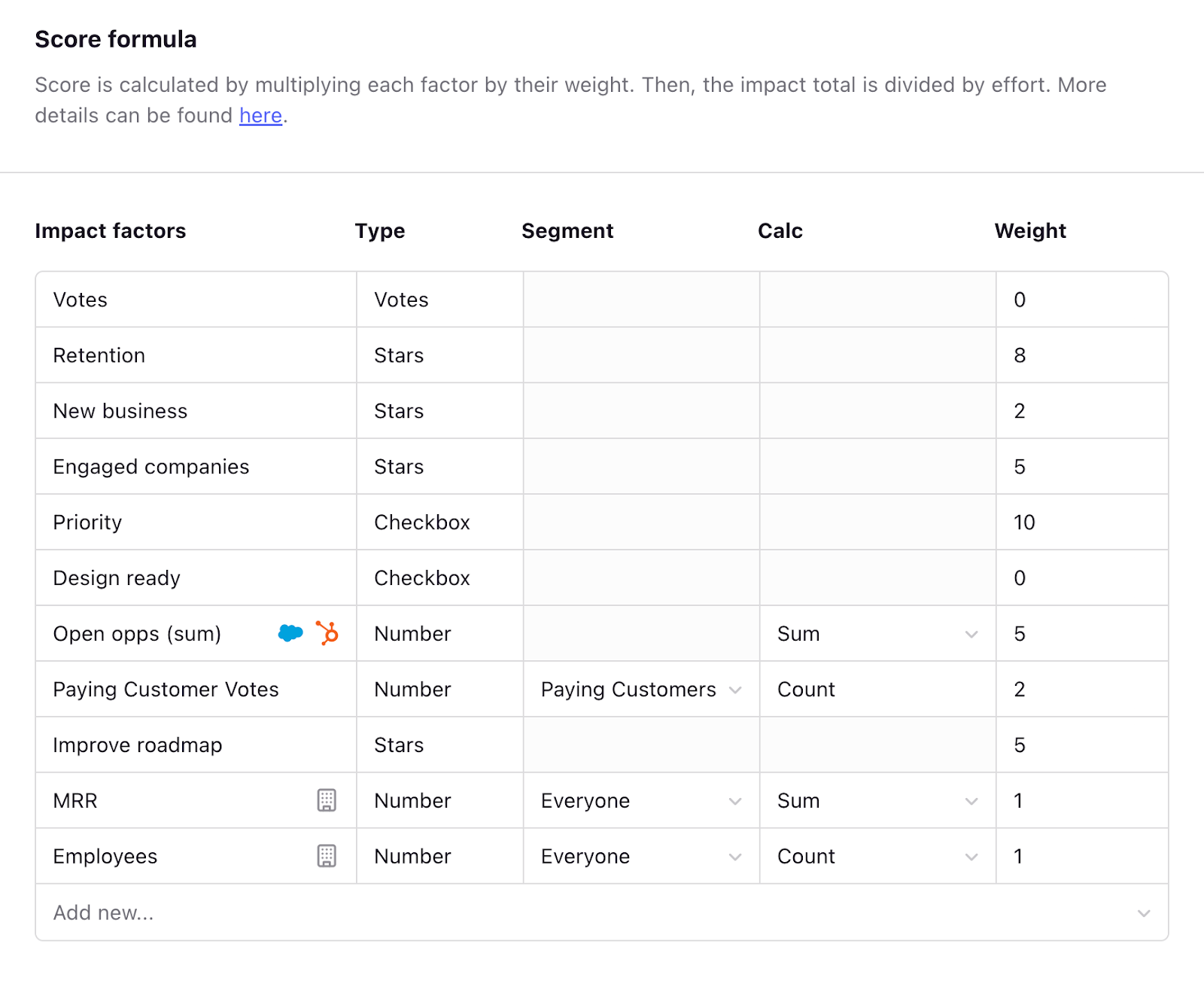
We add these factors to our prioritization formula in Canny. It then scores ideas for us and tells us what the biggest priority should be. From there, it’s easy to add the winning ideas to the product roadmap and get to work.
Priority
Explicitly stating the priority level helps everyone know what to do first and what can wait. This goes beyond just the prioritization criteria we discussed above.
Votes
Vote counts can indicate the demand or popularity of a feature, ensuring user needs are front and center. This is especially true for user-driven roadmaps.
You can use votes as one of your prioritization factors.
Owners
Assigning ownership ensures accountability. It shows who is in charge of a task or feature, clarifying roles and responsibilities.
Displaying ownership publicly helps align all your teams.
Deadlines
Deadlines provide a timeframe for delivery. They set expectations and ensure timely progress, keeping the momentum going.
Clearly visible deadlines help with accountability.
Status
Keeping track of the status of each task or feature provides a real-time snapshot of progress. It helps in managing resources and setting stakeholder expectations.
Effort
Estimating how much work a task needs helps assign resources and set realistic deadlines.
Part of building your roadmap is understanding how many resources you have. You also need to clarify what tasks the team can accomplish in a given time with that set of resources.
Milestones
Milestones are significant achievements or phases in the product’s journey. They provide checkpoints to gauge progress and celebrate successes, keeping the team motivated.
You can showcase your milestones through statuses or changelog entries (when a new feature is shipped).
Here’s how statuses work in Canny.
Here’s how AgencyAnalytics uses Canny’s changelog to share their important milestones.

As mentioned above, this is a very long list. So avoid including everything just for the sake of it. Rather, review this as a list of potential ideas and pick the ones that make the most sense to your organization. Focus on items that help you achieve your OKRs and boost your KPIs.
What not to include
If an item doesn’t add value, clarity, or align with the product’s direction, it’s best left out. Overloading a roadmap can dilute its purpose and make it overwhelming.
For example, if your company isn’t public, you don’t want to share any financials on your public roadmap.
If you have a low-impact feature request that you likely won’t get to, also don’t include it on your roadmap. This will set the wrong expectations.
Building a roadmap from scratch feels like a lot of work. That’s why we created our free roadmap templates!
If you’re looking for a more sophisticated roadmap tool that can help you automate this process, keep reading.
Roadmap tools
Canny offers a streamlined approach to roadmapping. Our product roadmap tool pulls in user feedback and helps you prioritize each idea in one platform. It’s like having a GPS for your product journey, ensuring you’re always on the right path.
There are other roadmap tools out there. Many aren’t designed for roadmaps, but can be adapted. For example, companies like SocialBee use Trello for their roadmap.
We’ve gathered the best public roadmap examples here – take a look! Drawing inspiration from successful examples can give you new ideas.
Now that you’ve built a roadmap, let’s discuss how to use it.
How to use the product roadmap
An effective product roadmap relies on its implementation. It’s not just about creating it, but also about driving alignment, decision-making, and progress. Let’s delve deeper into how to make the most of your roadmap.
- Communicate its value
It’s more than just a pretty visual. A roadmap is a strategic document that outlines a product’s vision, direction, and priorities. It is crucial to communicate its importance to all stakeholders, from developers to executives. So make sure everyone knows its purpose: to set expectations, clarify, and guide decisions. Refer to it frequently in meetings, presentations, and discussions to reinforce its importance.
Invite your users to review your roadmap if it is public. You should also provide them with the opportunity to submit ideas.
- Stick to it
It can be tempting to pursue every new idea or piece of feedback. Still, try to follow the plans you initially outlined in the roadmap. After all, you prioritized those ideas for a reason. This sets a direction and provides a sense of stability. And that’s the whole point of a roadmap!
You still need to strike a balance between consistency and adaptability, though. Your product plan can change due to market shifts, user feedback, or technological advancements. Being too rigid can lead to missed opportunities or misalignment with current needs.
Our advice: use your best judgment. Try not to get too distracted, but also be ready to pivot.
- Adjust as needed
The roadmap shouldn’t be set in stone. You may need to make changes as you collect more information, get feedback, or face unexpected obstacles.
Review your roadmap regularly. This way it’ll remain relevant and aligned with the product goal and market realities. Your roadmap will also evolve with the product, always pointing toward maximum value and impact.
A product roadmap is both a guide and a communication tool. Use it, reiterate its value, and stay consistent but flexible. And remember to make necessary adjustments. That’s how it can remain a dynamic tool that drives your product towards success.
Build better products with a roadmap
In the end, a roadmap is more than just a table. It’s your vision, strategy, and commitment to your product. So, grab that coffee, roll up your sleeves, and let’s build something amazing together!
Cheers to roadmaps and the clarity they bring! 🚀


